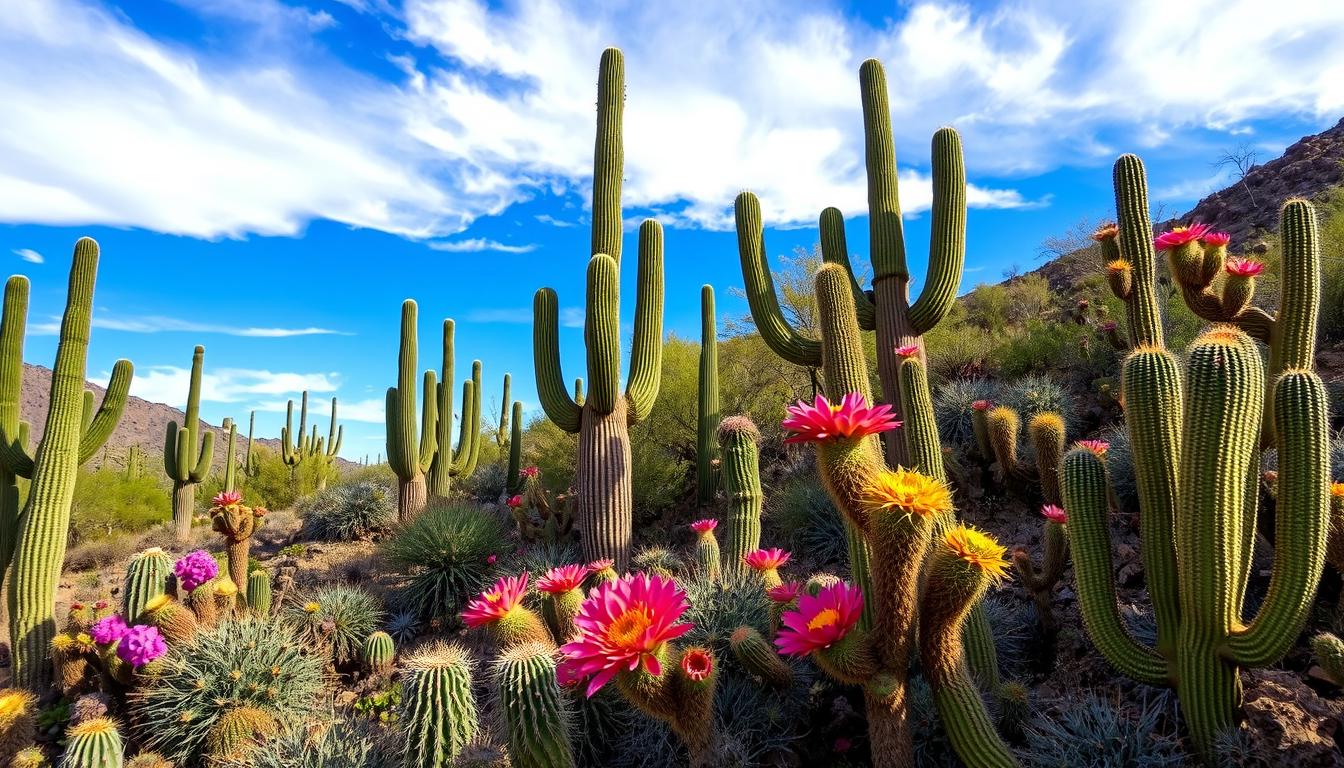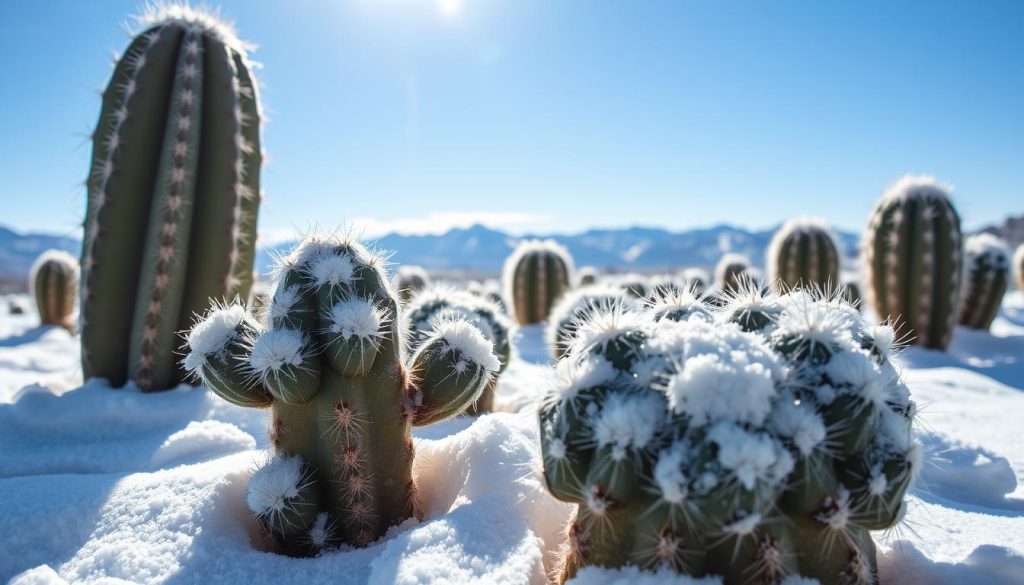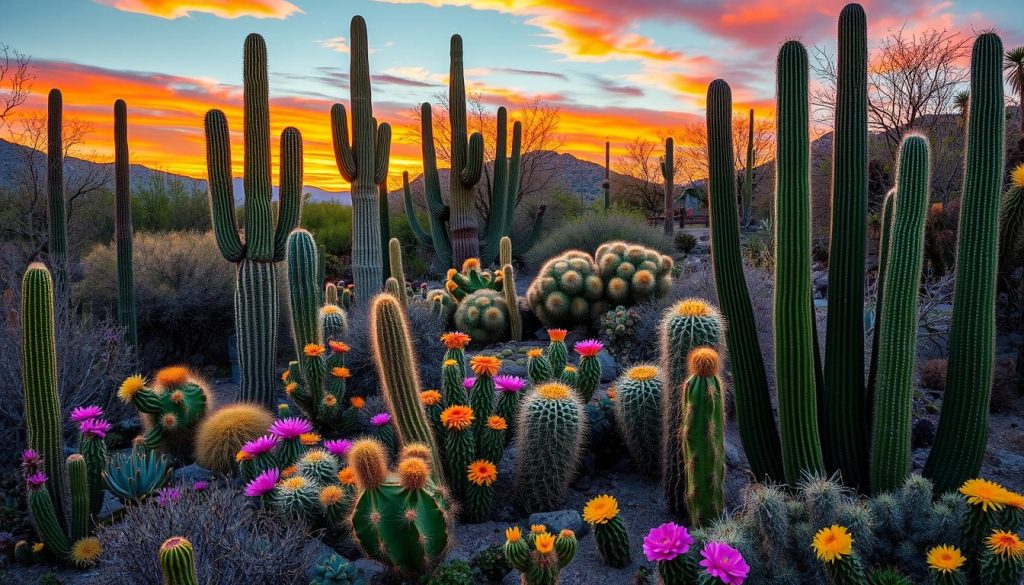Discover the Fascinating World of Cacti

Ever wondered why cacti are so special and tough? These desert plants have amazed people for centuries. They stand out with their spiny look, ability to live in dry places, and many shapes and sizes. Let’s explore the secrets of these amazing plants.
Key Takeaways
- Cacti are flowering plants native to hot, dry areas like deserts, known for their thick stems and sharp needle-like points.
- They belong to the Cactaceae family, with nearly 2,000 cactus species worldwide.
- Cacti have the unique ability to conserve water, allowing them to thrive in arid environments.
- The term “cacti” is the preferred plural term used globally in the botanical scientific community.
- Cacti exhibit a wide range of shapes and sizes, from globes to towering columns.
Cactus in History: The Spiny Legacy
Cacti have been part of human history for thousands of years. They originated in ancient Americas. These plants were crucial to indigenous peoples, used for medicine and as symbols of fertility and prosperity.
Ancient Civilizations and Cacti
The Incas and Aztecs were not alone in using cacti. Archaeologists found evidence of cacti as food for many groups in the Americas. The prickly pear cactus was especially important, providing nutrients and sweet fruits.
Introduction of Cacti to Europe
Christopher Columbus brought cacti to Europe on his second voyage in 1493. This sparked interest in these plants among European botanists and horticulturists. The prickly pear cactus, or Opuntia, became a favorite ornamental plant.
The Smithsonian National Museum of Natural History has a vast cacti collection. It includes historic photographs, notes, and colorful cactus watercolors. This collection, along with the work of pioneers like Joseph Nelson Rose and Nathaniel Lord Britton, has helped us understand cacti’s rich history and diversity.
Cacti are Succulents – But Not All Succulents are Cacti!
Cacti are amazing plants that belong to the succulent family. Succulents store water in their thick stems or leaves. This helps them survive in dry places. But, not every succulent is a cactus.
Cacti have special features that make them stand out. They have areoles, small, woolly pads that grow spines, flowers, and new growth. These spines protect them from animals and save water.
The variety of cacti is incredible. They range from small balls to tall columns. Some even change color with their surroundings, showing their amazing ability to adapt.
While cacti are from the Americas, succulents are found all over the world. They live in deserts and tropical areas. There are over 60 plant families with succulents.
Looking at a Saguaro cactus or an Echeveria succulent is truly captivating. Their unique features and wide variety make them fascinating for plant lovers and gardeners.
Cactus Spines are Modified Leaves
Many think cactus spines are just leaves, but they’re not. They are modified leaves that have evolved to help cacti survive in the desert.
Spines: Nature’s Ingenious Adaptation
Cactus spines are a clever example of nature’s design. They started as leaves but changed to help the cactus. These spines shade the plant, protecting it from too much sun and water loss. They also keep animals from eating the plant.
The spines are key in keeping the cactus cool and moist. In dry places, this is very important. They cast a shadow, which helps the cactus save water and stay healthy.
Each cactus has its own unique spines. They vary in shape, size, color, and texture. Some are thin and soft, while others are thick and hard. This variety helps each cactus adapt in its own way.
- Cacti spines are modified leaves that develop from living spine primordia and then die back to form hard spines.
- Cacti have areoles that sit on bases called tubercules, which sometimes have long, nipple-shaped tubercles on which spines grow.
- Spines on cactus plants come in various shapes, sizes, colors, and textures, such as thin, thick, ridged, flattened, feathery, twisted, and colorful, depending on the cactus variety.
Learning about cactus spines helps us understand how these plants survive. It shows us the amazing ways they adapt to their environment.
Cactus Have Adapted to Live in Hot & Arid Climates
Cacti are amazing plants that have learned to live in the hottest and driest places. They can store up to 200 liters of water in their thick stems. This lets them go without rain for a long time.
They also have a special trick to save water. Instead of leaves, they have sharp spines or modified leaves called cladodes. This helps them lose less water to the sun and dry air.
Cold-Hardy Cacti: Thriving in Extreme Conditions
Some cacti can even handle very cold temperatures. The Echinocereus triglochidiatus, or Claret Cup Cactus, is a great example. It has a thick, waxy coating to protect itself from frost and can handle freezing temperatures.
The Echinocereus triglochidiatus shows how adaptable cacti can be. These plants can handle both extreme heat and cold. They are truly remarkable survivors in tough environments.

Some Cacti Can Live for Over 200 Years
The cactus family, Cactaceae, has over 1,500 species worldwide. Many of these cacti live for more than 200 years in the wild. The Saguaro Cactus and Old Man Cactus are famous for their long lives, reaching ages of 200 years or more.
Saguaro cacti grow up to 50 feet tall and develop unique arms after 75-100 years. They can live for two centuries, with roots stretching up to 100 feet. Yet, only 1% of their seeds grow due to the desert’s harsh conditions and wildlife interest.
The Old Man Cactus, from Mexico, also lives over 200 years. It gets its name from its shaggy look as it ages. Its long life shows how well cacti adapt to harsh, dry places.
Cactus lifespan varies by species, growing conditions, and care. But, it’s clear these plants can live a long time. The Saguaro and Old Man Cacti are just a few examples of cacti that can live for centuries. They show the amazing resilience and adaptability of desert plants.
Saguaro Cactus Facts: The Incredible Secrets of the Giant Cactus
The saguaro cactus, known as Carnegiea gigantea, is a wonder of the Sonoran Desert. It can live up to 200 years, one of the longest-living cacti. It grows very slowly, taking about 10 years to grow 1.5 inches tall.
As it grows, a saguaro can get up to 6 arms. The first arm appears when it’s 50-70 years old. Its roots spread up to 100 square feet, and its stems can hold up to 200 liters of water. This helps it survive in the dry Sonoran Desert.
The saguaro’s flowers bloom on its stem tips, and it has red fruits that many desert animals eat. The Gila Woodpecker is especially important. It helps the saguaro by making nesting cavities for other animals.
The saguaro is key to the Sonoran Desert’s ecosystem. It offers both home and food for many animals. Its tall stature and special features make it a natural wonder.
Cacti Come in Different Shapes and Sizes
The cactus family is incredibly diverse. Plants range from small, round globes to tall, columnar ones. This variety shows how adaptable and resilient these unique succulents are.
From Globes to Towering Columns
The tallest cactus is the Mexican Gigantic Cardon (Pachycereus pringlei), reaching up to 50 feet. In the United States, the saguaro (Carnegiea gigantea) is the largest, growing up to 50 feet tall and weighing up to 12,000 pounds.
Some cacti grow tall and columnar, while others spread out near the ground. The Golden Barrel Cactus (Echinocactus grusonii) can grow up to 4 feet tall. The Bunny Ear Cactus (Opuntia microdasys) and the Moon Cactus (Gymnocalycium mihanovichii) stay low-growing.
The Old Lady Cactus (Mammillaria hahniana) is fuzzy, while the Organ Pipe Cactus (Stenocereus thurberi) is upright and pipe-like. These plants show the wide range of shapes cacti can take.

There are over 1,750 known species of cacti. This variety is amazing, from the tall Saguaro to the small Peanut Cactus (Mammillaria compressa), which grows only 6 inches tall. This diversity helps cacti thrive in many environments, from hot deserts to cool mountains.
Cacti Are Native to the Americas
Cacti, those iconic spiny plants, have a rich and fascinating history deeply rooted in the Americas. An amazing 1,749 out of 1,750 known cactus species call North and South America home. These plants thrive in the region’s arid and challenging environments, from the southwestern United States to Central and South America’s tropical forests.
The cactus family, Cactaceae, includes around 127 genera and about 1,750 species. All are native to the Americas, except for one Rhipsalis species found in Central America, the Caribbean, parts of South America, Africa, and Asia. This shows how deeply cacti are rooted in the Americas’ natural heritage.
Cacti have evolved to survive and thrive in the Americas’ hot, dry conditions. Their fleshy stems, modified leaves as spines, and drought-resistant strategies make them key to the region’s ecosystems. From the towering saguaro to the prickly pear, cacti symbolize the Americas’ natural wonders.
Cacti are guardians of the Americas’ natural heritage, captivating and inspiring people worldwide. Their unique and resilient nature showcases the incredible adaptability and diversity of life in this remarkable region.
Some Cacti Have Edible Pads & Fruits
Certain cacti are not just beautiful and tough. They also have edible parts like pads and fruits. The pads of the Prickly Pear cactus are a big deal in Mexican cooking. For centuries, people have eaten the fruits of different cacti.
These parts of the cactus have been a food source for people in dry places. They show how cacti have been important in human history and culture.
Edible cacti are found in warm, dry areas. You can find them in Latin groceries and some specialty stores. Popular ones include Prickly Pear, Barrel Cactus, and Dragon Fruit Cactus.
While most cacti are safe to eat, getting to them can be hard. Some might even taste bad.
The Prickly Pear cactus stands out for its edible parts. Its pads, or “nopales,” are full of good stuff like vitamins and fiber. The fruits are packed with vitamin C, calcium, and antioxidants.
These fruits are great for making syrups, candies, and more. The pads can be pickled, grilled, or stuffed with cheese.
People have been growing and eating cacti for a long time. The Aztecs and Incas used them as food. Today, people still grow and eat them, enjoying their unique taste and health benefits.
Most Popular Cactus Species
The world of cacti is full of fascinating species. Each one has its own unique features and appeal. From the towering Saguaro Cactus to the culturally significant Peyote Cactus, these plants have captured the hearts of many.
Saguaro Cactus (Carnegiea gigantea)
The Saguaro Cactus is a symbol of the American Southwest. It’s known for its tall height and distinctive arms. These slow-growing giants can grow up to 60 feet tall and live over 150 years.
Peyote Cactus (Lophophora Williamsii)
The Peyote Cactus holds cultural and spiritual significance, especially in Native American traditions. Its unique shape and spineless appearance make it visually striking. This cactus has caught the attention of botanists and collectors.
San Pedro Cactus (Trichocereus Pachanoi)
The San Pedro Cactus is known for its fast growth and history in shamanic practices. It has a tall, slender form and a distinctive green color. This makes it a favorite for both indoor and outdoor gardens.
Barrel Cactus (Echinocactus grusonii)
The Barrel Cactus is loved for its rounded shape and golden spines. It’s a hardy plant that thrives in various climates. It’s often used in xeriscape landscaping.
Prickly Pear Cactus (Opuntia)
The Prickly Pear Cactus is one of the most widespread species. It’s prized for its edible pads and vibrant flowers. The juicy fruits are also a favorite in many dishes.
Cactus Habitat and Adaptations
Cacti are amazing plants that live in the tough, dry deserts. They store water in their stems, lose less water because of their small leaves, and have strong spines for protection. These features help them survive in harsh places.
The desert where cacti live is very dry, hot, and sunny. For example, the Agate desert gets only 15 inches of rain a year. Cacti have thick stems to hold water and a waxy layer to keep water in.
Cacti are also important for animals in the desert. They offer food and shelter. The spines and flowers on cacti keep animals away and help save water.
It’s important to understand and protect these desert plants. Learning about cacti’s special ways helps us see how strong and vital they are.
Cacti have amazing ways to live in the desert. They store water in their stems and have small leaves to lose less water. Their strong spines and special photosynthesis help them survive in dry places.
Cacti also help animals in the desert. They provide food and shelter. Saving these plants is key to keeping the desert healthy.
Conclusion
The world of cactus plants is truly fascinating. It shows us the wonders of our planet. From the tall Saguaro Cactus in the Sonoran Desert to the small Christmas Cactus in our homes, cacti amaze us all.
They are not just plants; they are survivors. Their unique features, like spines and water storage, are incredible. These plants can even make our homes feel like the desert.
We must protect these amazing plants for the future. By learning more about cacti, we can help save them. This way, we can keep enjoying their beauty and wonder for many years.


